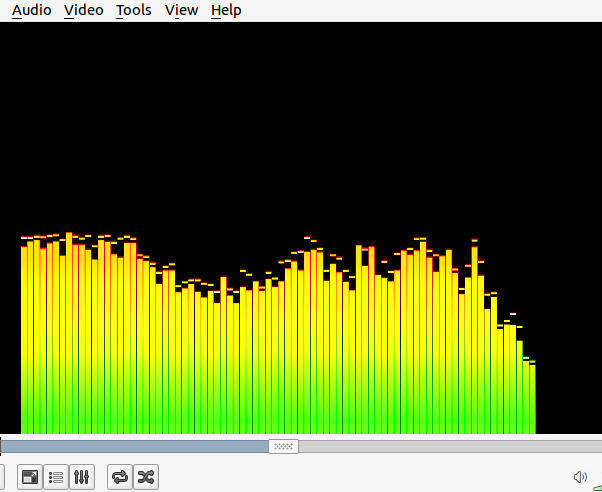Documentation:Audio
Using the VLC media player, you can play audio files of different formats. You can enable tracks, convert audio tracks, view tracks in various visualizations, and set visualizations. Audio tracks of the .asf, .avi, .divx, .dv, .mxf, .ogg, .gm, .ps, .ts, .vob, and .wmv formats are supported.
Note: The options under the Audio menu are enabled only if an audio file is played.
Playing an Audio Track
You can play, enable and disable an audio track. To play a track:
- Select Open File from the Media menu.
- Select an audio file and click on the
 Open button. The selected track is played.
Open button. The selected track is played. - To disable a track, select the Disable option in the Audio Track from the Audio menu. The selected track will then stop.
- To play the same track again, select the designated Track option in the Audio Track from the Audio menu. The selected track will then play.
Audio Device
This option helps you to listen to audio files in two modes: stereo and mono.
- To listen to an audio track in either the Stereo or Mono mode, select Open File or Open Disc from the Media menu. The Open dialog box is displayed.
- Select an audio file and click on the
 Play button. The selected track is played.
Play button. The selected track is played. - Select Mono in Audio Device from the Audio menu if you want to listen to the audio track in the Mono mode.
Mono refers to monaural sound that uses a single channel for sound reproduction.
- Select Stereo in Audio Device from the Audio menu if you want to listen to the audio track in the Stereo mode.
Stereo refers to sound that uses two channels for sound reproduction or stereophonic sound.
Audio Channels
In audio, a channel refers to a stream of audio that is to be played by one speaker. For example, stereo audio, consists of two channels. This option is useful for codecs that don’t have support for more than 2 channels.
Select a channel type in Audio Channels from the Audio menu. VLC media player provides four audio channels and they are:
- Stereo – Refers to the reproduction of the sound in two or more independent audio channels using more than one speaker. If you use this option, you would feel as though the sound is played from all the directions. You can observe this in a regular home theatre with 5.1 or 6.1 speakers.
- Left – You can observe this in a regular audio player with 2.1 speakers. If you select the Left option, the music is played only in the left speaker. The speaker on your right is automatically switched OFF.
- Right - If you select the Right option, the music is played only in the speaker on your right side. The speaker on your left is automatically switched OFF.
- Reverse Stereo – There are several applications that are used to reverse the stereo whereas VLC has an in-built feature to reverse the stereo. This option is useful if you want the audio to play in tandem with the video. You can use the Reverse Stereo option if you want to deliberately change the audio output.
Imagine that you are watching a video. In the video, a person walks on the left side but the sound is produced on the right speaker. You can correct this by selecting the Reverse Stereo option in VLC. Select the Reverse Stereo option and play the same scene in the video and observe the difference.
You can observe this with 2.1, 5.1, 6.1 and 8.1 speakers.
Visualize Audio
Visualizations display splashes of colour and geometric shapes and generate animated imagery based on a piece of music.
The different visual effects available are Spectrometer, Scope, Spectrum, VU Meter and Goom. This menu item can also be used to disable a visualization.
- Select an option under the Visualizations option from the Audio menu to view the effects. The selected visualization is then played.
- To disable visualizations, select Disable under Visualizations from the Audio menu. The visualization is then disabled.
Spectrum visualization on vlc:
